Solar eclipse of March 30, 2052
A total solar eclipse will occur at the Moon's descending node of the orbit on Saturday, March 30, 2052. A solar eclipse occurs when the Moon passes between Earth and the Sun, thereby totally or partly obscuring the image of the Sun for a viewer on Earth. A total solar eclipse occurs when the Moon's apparent diameter is larger than the Sun's, blocking all direct sunlight, turning day into darkness. Totality occurs in a narrow path across Earth's surface, with the partial solar eclipse visible over a surrounding region thousands of kilometres wide. The path of totality will cross central Mexico and the southeastern states of the United States. Almost all of North America and the northern edge of South America will see a partial eclipse. It will be the 2nd total eclipse visible from the Florida Panhandle and southwest Georgia in 6.6 years. It will be the first total solar eclipse visible from Solar Saros 130 in 223 synodic months. It will be the last total solar eclipse visible in the United States until May 11, 2078.
Related eclipses
Solar eclipses 2051–2054
This eclipse is a member of a semester series. An eclipse in a semester series of solar eclipses repeats approximately every 177 days and 4 hours (a semester) at alternating nodes of the Moon's orbit.[1]
| Solar eclipse series sets from 2051 to 2054 | ||||
|---|---|---|---|---|
| Descending node | Ascending node | |||
| Saros | Map | Saros | Map | |
| 120 | April 11, 2051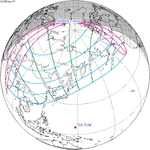 Partial | 125 | October 4, 2051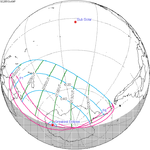 Partial | |
| 130 | March 30, 2052 Total | 135 | September 22, 2052 Annular | |
| 140 | March 20, 2053 Annular | 145 | September 12, 2053 Total | |
| 150 | March 9, 2054 Partial | 155 | September 2, 2054 Partial | |
Saros 130
This eclipse is a part of Saros cycle 130, repeating every 18 years, 11 days, containing 73 events. The series started with partial solar eclipse on August 20, 1096. It contains total eclipses from April 5, 1475 through July 18, 2232. There are no annular eclipses in the series. The series ends at member 73 as a partial eclipse on October 25, 2394. The longest duration of totality was 6 minutes, 41 seconds on July 11, 1619. All eclipses in this series occurs at the Moon’s descending node.[2]
| Series members 43–56 between 1853 and 2300 | ||
|---|---|---|
| 43 | 44 | 45 |
 November 30, 1853 |  December 12, 1871 | 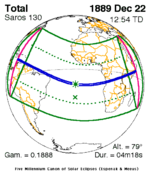 December 22, 1889 |
| 46 | 47 | 48 |
 January 3, 1908 |  January 14, 1926 |  January 25, 1944 |
| 49 | 50 | 51 |
 February 5, 1962 |  February 16, 1980 |  February 26, 1998 |
| 52 | 53 | 54 |
 March 9, 2016 |  March 20, 2034 |  March 30, 2052 |
| 55 | 56 | 57 |
 April 11, 2070 |  April 21, 2088 |  May 3, 2106 |
| 58 | 59 | 60 |
 May 14, 2124 |  May 25, 2142 | 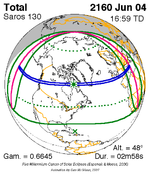 June 4, 2160 |
| 61 | 62 | 63 |
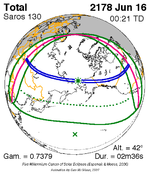 June 16, 2178 | 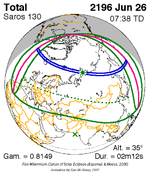 June 26, 2196 |  July 8, 2214 |
| 64 | 65 | 66 |
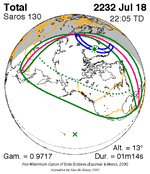 July 18, 2232 |  July 30, 2250 | 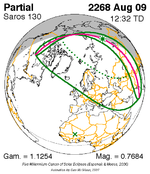 August 9, 2268 |
| 67 | ||
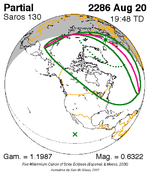 August 20, 2286 | ||
Inex series
This eclipse is a part of the long period inex cycle, repeating at alternating nodes, every 358 synodic months (≈ 10,571.95 days, or 29 years minus 20 days). Their appearance and longitude are irregular due to a lack of synchronization with the anomalistic month (period of perigee). However, groupings of 3 inex cycles (≈ 87 years minus 2 months) comes close (≈ 1,151.02 anomalistic months), so eclipses are similar in these groupings.
| Inex series members between 1901 and 2100: | ||
|---|---|---|
 July 10, 1907 (Saros 125) |  June 19, 1936 (Saros 126) |  May 30, 1965 (Saros 127) |
 May 10, 1994 (Saros 128) |  April 20, 2023 (Saros 129) |  March 30, 2052 (Saros 130) |
 March 10, 2081 (Saros 131) | ||
Metonic cycle
The metonic series repeats eclipses every 19 years (6939.69 days), lasting about 5 cycles. Eclipses occur in nearly the same calendar date. In addition, the octon subseries repeats 1/5 of that or every 3.8 years (1387.94 days).
| 21 eclipse events between June 12, 2029 and June 12, 2105 | ||||
|---|---|---|---|---|
| June 11–12 | March 30–31 | January 16 | November 4–5 | August 23–24 |
| 118 | 120 | 122 | 124 | 126 |
 June 12, 2029 |  March 30, 2033 |  January 16, 2037 |  November 4, 2040 |  August 23, 2044 |
| 128 | 130 | 132 | 134 | 136 |
 June 11, 2048 |  March 30, 2052 |  January 16, 2056 |  November 5, 2059 |  August 24, 2063 |
| 138 | 140 | 142 | 144 | 146 |
 June 11, 2067 |  March 31, 2071 |  January 16, 2075 |  November 4, 2078 |  August 24, 2082 |
| 148 | 150 | 152 | 154 | |
 June 11, 2086 |  March 31, 2090 |  January 16, 2094 |  November 4, 2097 | |
Notes
References
- Earth visibility chart and eclipse statistics Eclipse Predictions by Fred Espenak, NASA/GSFC
- Google interactive map
- Besselian elements
- v
- t
- e
| By era | |
|---|---|
| Saros series | |
| Visibility | |
| Historical |
|

Total/hybrid eclipses
→ next total/hybrid
- 1560
- 1598
- 1652
- 1654
- 1673
- 1699
- 1706
- 1715
- 1724
- 1766
- 1778
- 1780
- 1806
- 1816
- 1824
- 1842
- 1851
- 1853
- 1857
- 1858
- 1860
- 1865
- 1867
- 1868
- 1869
- 1870
- 1871
- 1874
- 1875
- 1878
- 1882
- 1883
- 1885
- 1886
- 1887
- Jan 1889
- Dec 1889
- 1893
- 1896
- 1898
- 1900
- 1901
- 1903
- 1904
- 1905
- 1907
- Jan 1908
- Dec 1908
- 1909
- 1910
- 1911
- Apr 1912
- Oct 1912
- 1914
- 1916
- 1918
- 1919
- 1921
- 1922
- 1923
- 1925
- 1926
- 1927
- 1928
- 1929
- Apr 1930
- Oct 1930
- 1932
- 1934
- 1936
- 1937
- 1938
- 1939
- 1940
- 1941
- 1943
- Jan 1944
- 1945
- 1947
- 1948
- 1950
- 1952
- 1954
- 1955
- 1956
- 1957
- 1958
- 1959
- 1961
- 1962
- 1963
- 1965
- 1966
- 1967
- 1968
- 1970
- 1972
- 1973
- 1974
- 1976
- 1977
- 1979
- 1980
- 1981
- 1983
- 1984
- 1985
- 1986
- 1987
- 1988
- 1990
- 1991
- 1992
- 1994
- 1995
- 1997
- 1998
- 1999
- 2001
- 2002
- 2003
- 2005
- 2006
- 2008
- 2009
- 2010
- 2012
- 2013
- 2015
- 2016
- 2017
- 2019
- 2020
- 2021
- 2023
- → 2024
- 2026
- 2027
- 2028
- 2030
- 2031
- 2033
- 2034
- 2035
- 2037
- 2038
- 2039
- 2041
- 2042
- 2043
- 2044
- 2045
- 2046
- 2048
- 2049
- 2050
- 2052
- 2053
- 2055
- Jan 2057
- Dec 2057
- 2059
- 2060
- 2061
- 2063
- 2064
- 2066
- 2067
- 2068
- 2070
- 2071
- 2072
- 2073
- 2075
- 2076
- 2077
- 2078
- 2079
- 2081
- 2082
- 2084
- 2086
- 2088
- 2089
- 2090
- 2091
- 2093
- 2094
- 2095
- 2096
- 2097
- 2099
- 2100
- 2114
- 2117
- 2126
- 2132
- 2150
- 2153
- 2168
- 2178
- 2186

Annular eclipses
→ next annular
- 1820
- 1854
- 1879
- 1889
- 1900
- 1901
- 1903
- 1904
- 1905
- 1907
- 1908
- 1911
- 1914
- Feb 1915
- Aug 1915
- 1916
- 1917
- 1918
- 1919
- 1921
- 1922
- 1923
- 1925
- 1926
- 1927
- 1929
- 1932
- Feb 1933
- Aug 1933
- 1934
- 1935
- 1936
- 1937
- 1939
- 1940
- 1941
- 1943
- Jul 1944
- 1945
- 1947
- 1948
- 1950
- Mar 1951
- Sep 1951
- 1952
- Jan 1954
- Dec 1954
- 1955
- 1957
- 1958
- 1959
- 1961
- 1962
- 1963
- 1965
- 1966
- Mar 1969
- Sep 1969
- 1970
- 1972
- Jan 1973
- Dec 1973
- 1976
- 1977
- 1979
- 1980
- 1981
- 1983
- 1984
- 1987
- 1988
- 1990
- 1991
- 1992
- 1994
- 1995
- 1998
- 1999
- 2001
- 2002
- 2003
- 2005
- 2006
- 2008
- 2009
- 2010
- 2012
- 2013
- 2014
- 2016
- 2017
- 2019
- 2020
- 2021
- 2023
- → 2024
- 2026
- 2027
- 2028
- 2030
- 2031
- 2032
- 2034
- 2035
- 2036
- Jan 2038
- Jul 2038
- 2039
- 2041
- 2042
- 2043
- 2044
- 2045
- 2046
- 2048
- 2049
- 2052
- 2053
- Jan 2056
- Jul 2056
- 2057
- 2059
- 2060
- 2061
- 2063
- 2064
- 2066
- 2067
- 2070
- 2071
- Jan 2074
- Jul 2074
- 2075
- 2077
- 2078
- 2079
- 2081
- 2082
- 2084
- Jun 2085
- Dec 2085
- 2088
- 2089
- Feb 2092
- Aug 2092
- 2093
- 2095
- 2096
- 2097
- 2099
- 2100
- 2101
- Jan 2168
- Dec 2168
- Apr 2191
- 2200

Partial eclipses
→ next partial
- Jan 1639
- Apr 1902
- May 1902
- Oct 1902
- Feb 1906
- Jul 1906
- Aug 1906
- Dec 1909
- Nov 1910
- Apr 1913
- Aug 1913
- Sep 1913
- Dec 1916
- Jan 1917
- Jun 1917
- Jul 1917
- May 1920
- Nov 1920
- Mar 1924
- Jul 1924
- Aug 1924
- Dec 1927
- Jun 1928
- Nov 1928
- Apr 1931
- Sep 1931
- Oct 1931
- Jan 1935
- Feb 1935
- Jun 1935
- Jul 1935
- Nov 1938
- Mar 1942
- Aug 1942
- Sep 1942
- Jan 1946
- May 1946
- Jun 1946
- Nov 1946
- Apr 1949
- Oct 1949
- Feb 1953
- Jul 1953
- Aug 1953
- Dec 1956
- Mar 1960
- Sep 1960
- Jan 1964
- Jun 1964
- Jul 1964
- Dec 1964
- May 1967
- Mar 1968
- Feb 1971
- Jul 1971
- Aug 1971
- Dec 1974
- May 1975
- Nov 1975
- Apr 1978
- Oct 1978
- Jan 1982
- Jun 1982
- Jul 1982
- Dec 1982
- May 1985
- Apr 1986
- Mar 1989
- Aug 1989
- Dec 1992
- May 1993
- Nov 1993
- Apr 1996
- Oct 1996
- Sep 1997
- Feb 2000
- 1 Jul 2000
- 31 Jul 2000
- Dec 2000
- Apr 2004
- Oct 2004
- Mar 2007
- Sep 2007
- Jan 2011
- Jun 2011
- Jul 2011
- Nov 2011
- Oct 2014
- Sep 2015
- Feb 2018
- Jul 2018
- Aug 2018
- Jan 2019
- Apr 2022
- Oct 2022
- → Mar 2025
- Sep 2025
- Jan 2029
- Jun 2029
- Jul 2029
- Dec 2029
- 2032
- 2033
- Feb 2036
- Jul 2036
- Aug 2036
- 2037
- May 2040
- Nov 2040
- Jan 2047
- Jun 2047
- Jul 2047
- Dec 2047
- 2050
- Apr 2051
- Oct 2051
- Mar 2054
- Aug 2054
- Sep 2054
- 2055
- May 2058
- Jun 2058
- Nov 2058
- Mar 2062
- Sep 2062
- Feb 2065
- Jul 2065
- Aug 2065
- Dec 2065
- 2068
- Apr 2069
- May 2069
- Oct 2069
- 2072
- 2073
- Jun 2076
- Jul 2076
- Nov 2076
- Feb 2083
- Jul 2083
- Aug 2083
- 2084
- 2086
- May 2087
- Jun 2087
- Oct 2087
- 2090
- 2091
- Jun 2094
- Jul 2094
- Dec 2094
- Apr 2098
- Sep 2098
- Oct 2098
- Apr 2108
- Jul 2195
 Astronomy portal
Astronomy portal Solar System portal
Solar System portal Category
Category
 | This solar eclipse–related article is a stub. You can help Wikipedia by expanding it. |
- v
- t
- e












